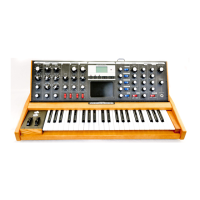15
- When a key is pressed, A Gate and Pitch CV are produced by the keyboard. The
Gate signal is used to trigger both the Filter and Volume Envelopes. The Pitch CV is
used to determine the pitch of the Oscillators and can be applied to a varying
degree to the Filters through the Keyboard Control Amount knob.
- Modulation is performed through the Modulation Busses. There are two separate
Mod busses. One is controlled by the Mod Wheel, while the other is controlled by
the MOD1 CV input. If nothing is plugged into the MOD1 CV Input, then the
PEDAL/ON bus is on at the level determined by the Amount control. In each Mod
Bus, a Modulation Source, Shaping signal and Destination are selected. An overall
maximum modulation amount can be set with the Amount control. The Modulation
CV paths are illustrated in figure 16.

